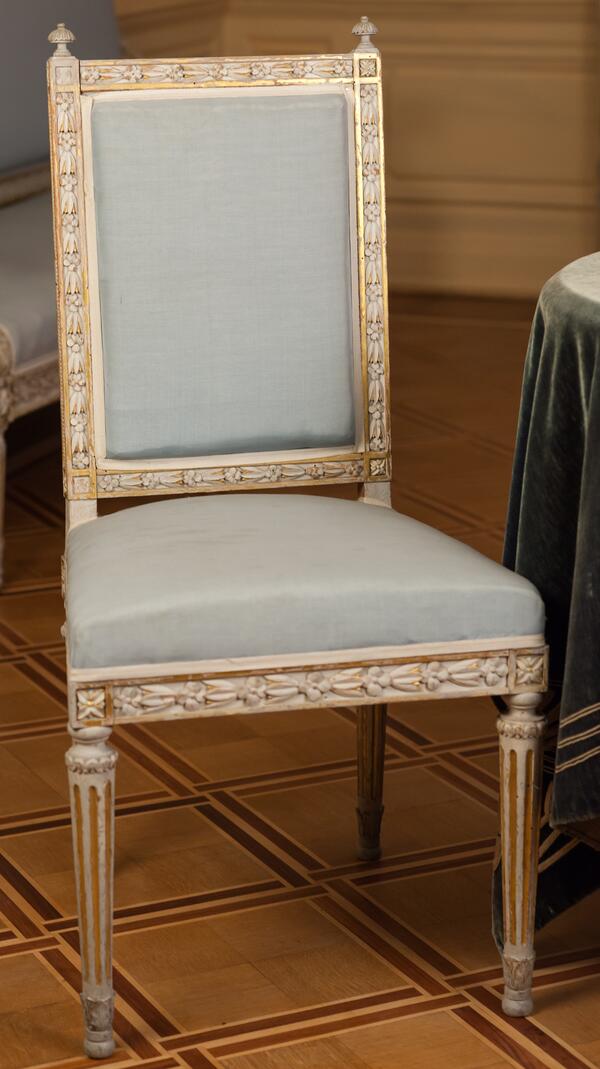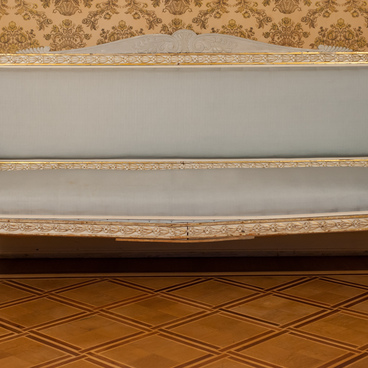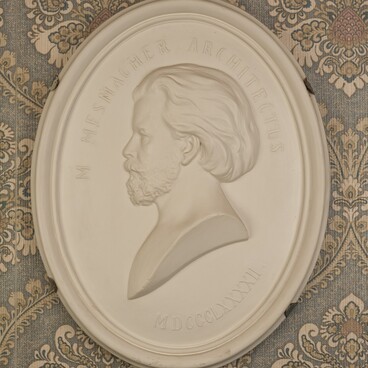The blue chair is part of a sixteen-piece state furniture set arrived to Massandra museum from the Hermitage. Judging by its shape and ornamental design, this chair is a product of a Russian workshop from the first quarter of the nineteenth century.
The padded backrest is bordered with a profiled wooden frame. An incised foliage ornament is attached to the front of the frame and beads to its sides. The crest rail is topped with two urn shaped finials. Four round turned legs end with acanthus leaf carvings. These forms are inspired by classical Greco-Roman art: the grooves on the legs resemble the fluting of classical columns, while acanthus is a classical foliage ornament imitating the eponymous Mediterranean species with deep-cut leaves.
What you see is an example of a state furniture set: it is elaborately carved, painted and covered with gold leaf. The wood would be coated in a gesso primer substrate, over which oil paint would be applied, preferably white, light pink, light blue, or light green with a touch of gold leaf. Fabrics for upholstery were chosen to match the palette.
In the first third of the 19th century, Neoclassicism was integral to furniture design in Russia, evolving into what would later be called Russian Classicism. This style was so universal and prominent overall that it went down in history as a highlight of Russian applied arts. During that period, Russia stopped importing foreign-made furniture since Empress Catherine II forbade it. Her decision gave rise to national furniture industry. Even serfs in landlords’ country estates could build top-quality furniture in different styles.
Russian Neoclassical furniture maintained its clean-cut shapes, but added new proportions and details inspired by classical Greco-Roman art. Its forms were monumental but not cumbersome, and the general outline became light and elegant. Its articulation was strictly balanced and the decoration frugal but graceful. The rhythmic symmetry of the ornaments was indicative of Neoclassical style.
All these features of Russian Neoclassical furniture can be now seen in the items exhibited in Her Majesty’s Study.
The padded backrest is bordered with a profiled wooden frame. An incised foliage ornament is attached to the front of the frame and beads to its sides. The crest rail is topped with two urn shaped finials. Four round turned legs end with acanthus leaf carvings. These forms are inspired by classical Greco-Roman art: the grooves on the legs resemble the fluting of classical columns, while acanthus is a classical foliage ornament imitating the eponymous Mediterranean species with deep-cut leaves.
What you see is an example of a state furniture set: it is elaborately carved, painted and covered with gold leaf. The wood would be coated in a gesso primer substrate, over which oil paint would be applied, preferably white, light pink, light blue, or light green with a touch of gold leaf. Fabrics for upholstery were chosen to match the palette.
In the first third of the 19th century, Neoclassicism was integral to furniture design in Russia, evolving into what would later be called Russian Classicism. This style was so universal and prominent overall that it went down in history as a highlight of Russian applied arts. During that period, Russia stopped importing foreign-made furniture since Empress Catherine II forbade it. Her decision gave rise to national furniture industry. Even serfs in landlords’ country estates could build top-quality furniture in different styles.
Russian Neoclassical furniture maintained its clean-cut shapes, but added new proportions and details inspired by classical Greco-Roman art. Its forms were monumental but not cumbersome, and the general outline became light and elegant. Its articulation was strictly balanced and the decoration frugal but graceful. The rhythmic symmetry of the ornaments was indicative of Neoclassical style.
All these features of Russian Neoclassical furniture can be now seen in the items exhibited in Her Majesty’s Study.



